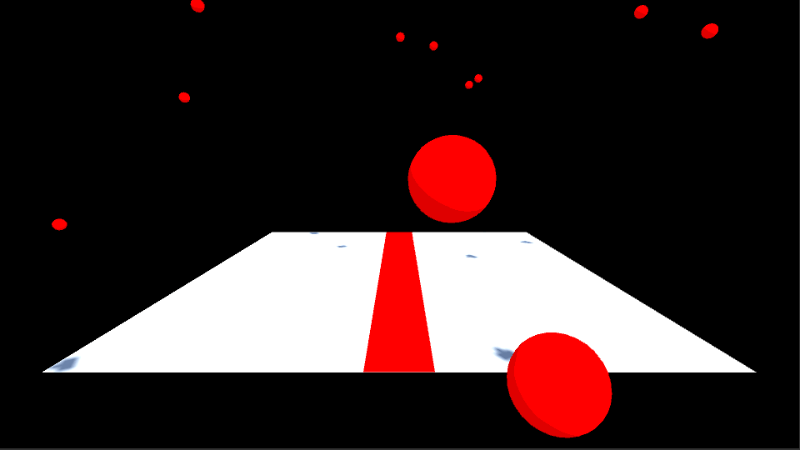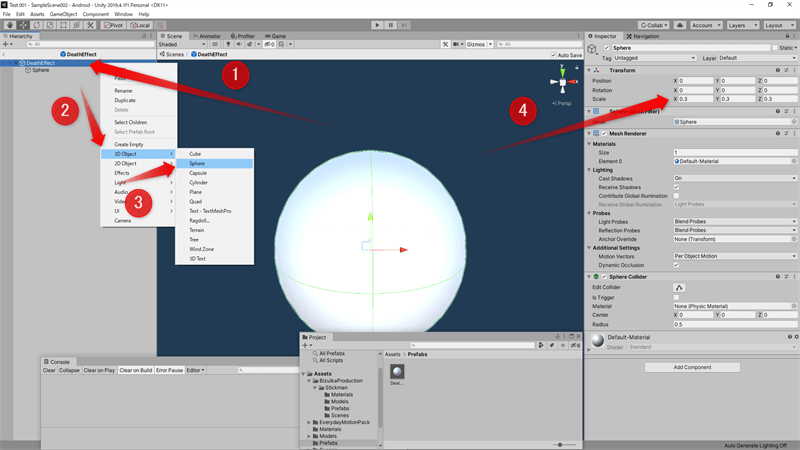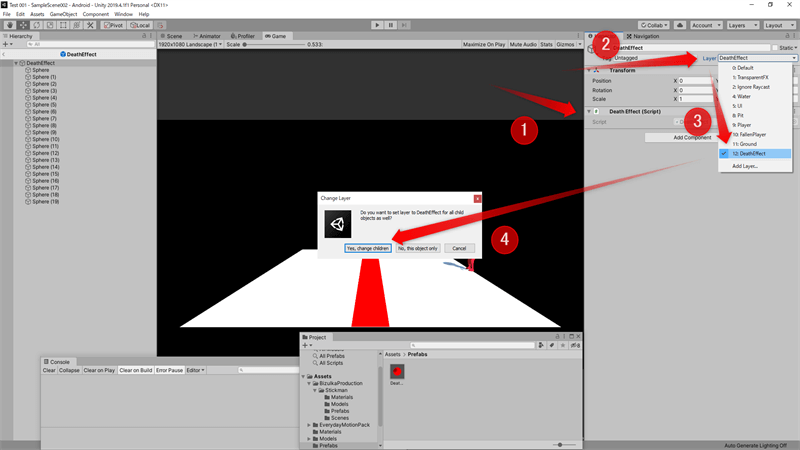
カジュアルなビジュアルスタイルのゲームと親和性の高い、木っ端微塵死亡エフェクトを実装。
ParticleSystemを使わず、小オブジェクトの生成で表現。
↓の自作ゲームで使用。
サンプル動画
真ん中の赤い床に接触すると破裂。
破片用のマテリアルを作成
- 上部メニュー -> Assets -> Create -> Materialを選択。
適当に「DeathEffectMaterial」と命名。- Shader:通常のままでも良いが、任意のシェーダーで。
- Albedo:任意の色に変更。
死亡エフェクトを作成
死亡エフェクト本体と破片オブジェクトを作成
*画像の番号と、手順の番号は対応してないです。流れとして御覧ください。

次項の「レイヤーの設定」と跨いでいます。

- 上部メニュー -> GameObject -> Create Emptyを選択。
DeathEffectと命名。 - DeathEffectスクリプトを作成し、アタッチ。
- ヒエラルキー -> DeathEffectを右クリック -> 3D Object -> Sphereを選択。
続いて設定。- インスペクター -> Transformコンポーネント -> Scaleを(0.3, 0.3, 0.3)程に変更。
- インスペクター -> Mesh Rendererコンポーネント -> Materials -> Element 0へ、「DeathEffectMaterial」を設定。
- インスペクタ -> Add Component -> Rigidbodyをアタッチ。
- ヒエラルキー -> Sphereを右クリック -> Duplicateで、Sphereを20個程まで複製。
(ヒエラルキーで複数選択して実行すると早い)
DeathEffect側のコード
using System.Collections;
//使わなかったので一応コメントアウト。
//using System.Collections.Generic;
using UnityEngine;
public class DeathEffect : MonoBehaviour
{
//破片のRigidbodyを保持。
Rigidbody[] childrenRigidbodies;
//爆発力。
float deathEffectForce = 15.0f;
//爆発の半径。
float deathEffectForceRadius = 10.0f;
//上向きに掛かる力の補正値。
float deathEffectUpwardsModifier = 1.0f;
Coroutine lifetimeTimer;
//非アクティブ化するまでの時間。
float lifetime = 5.0f;
void Awake()
{
childrenRigidbodies = GetComponentsInChildren<Rigidbody>();
SetRandomPosition();
}
//エフェクトを開始したい時に呼ぶ。
public void StartEffect()
{
for (int i = 0; i < childrenRigidbodies.Length; i++)
{
childrenRigidbodies[i].AddExplosionForce(deathEffectForce, transform.position, deathEffectForceRadius, deathEffectUpwardsModifier, ForceMode.Impulse);
}
lifetimeTimer = StartCoroutine("LifetimeTimer");
}
//毎回ランダムに散らばらせて配置している。
void SetRandomPosition()
{
for (int i = 0; i < childrenRigidbodies.Length; i++)
{
childrenRigidbodies[i].transform.position = Random.insideUnitSphere;
}
}
//(オブジェクトプールにするのを想定)リセット。
public void Reset()
{
ResetVelocity();
SetRandomPosition();
}
//(オブジェクトプールにするのを想定)加速度のリセット。破片には球体を使っているので、AngularVelocityはリセットしなくても多分大丈夫。
void ResetVelocity()
{
for (int i = 0; i < childrenRigidbodies.Length; i++)
{
childrenRigidbodies[i].velocity = Vector3.zero;
}
}
//一定時間経過で、非アクティブ化するタイマー。
IEnumerator LifetimeTimer()
{
yield return new WaitForSeconds(lifetime);
gameObject.SetActive(false);
Reset();
}
//ゲームオーバー等、タイマー以外で非アクティブ化した場合の、タイマーの強制終了用。
//Resetの方から呼んでも良いが、一応分けた。
public void ResetLifetimeTimer()
{
if (lifetimeTimer != null) {
StopCoroutine(lifetimeTimer);
lifetimeTimer = null;
}
}
}
(任意)一部レイヤーとの衝突判定を無効化
レイヤーの作成&変更
- インスペクター -> Layer(名前欄のやや下) -> Add Layer…を選択。
Tags&Layers画面を開き「DeathEffect」レイヤーを作成。 - 再びヒエラルキー -> DeathEffectを選択。
- インスペクター -> Layer -> DeathEffectを選択。
(Change Layerダイアログでは、Yes, change childrenを選択)
レイヤー間の衝突判定の無効化
*画像の番号と、手順の番号は対応してないです。

- 上部メニュー -> Edit -> Project Settings…を選択。
- Project Settingsウィンドウ -> サイドバーメニュー -> Physicsを選択。
- 下までスクロール -> Layer Collision Matrixで、DeathEffect x Player間等の衝突判定を無効化。
プレハブ化
- Projectウィンドウ -> 任意のフォルダに、DeathEffectをドラッグ&ドロップしてプレハブ化。
- ヒエラルキー -> DeathEffectを右クリック -> Deleteを選択、シーン上から削除。
プレイヤー側
- Player(対象とするオブジェクト)のメインスクリプトに追記。
もしくは、新規スクリプトを作成し、記述。 - ヒエラルキー -> Playerを選択。
- インスペクター -> Playerスクリプト -> deathEffectPrefabに、DeathEffectプレハブをフォルダからドラッグ&ドロップして紐付け。
- プレイヤーの死亡タイミングで、CreateDeathEffectを呼ぶ。
Player側のコード
//使わなかったので一応コメントアウト。
//using System.Collections;
//using System.Collections.Generic;
using UnityEngine;
public class Player : MonoBehaviour
{
//インスペクターでDeathEffectプレハブを紐付け。
[SerializeField]
GameObject deathEffectPrefab;
DeathEffect deathEffect;
void Awake()
{
//割愛するが、実際に使用する際には、リストにしてオブジェクトプール化するべき。
deathEffect = Instantiate(deathEffectPrefab).GetComponent<DeathEffect>();
deathEffect.gameObject.SetActive(false);
}
//呼び出しの例。各自で差し替えてください。
void OnCollisionEnter(Collision col)
{
if (col.gameObject.CompareTag("DamageFloor")) {
gameObject.SetActive(false);
CreateDeathEffect();
}
}
//プレイヤーの位置に移動させてから、アクティブ化して、エフェクト開始。
void CreateDeathEffect()
{
if (!deathEffect.gameObject.activeSelf) {
deathEffect.transform.position = transform.position;
deathEffect.gameObject.SetActive(true);
deathEffect.StartEffect();
}
}
}





